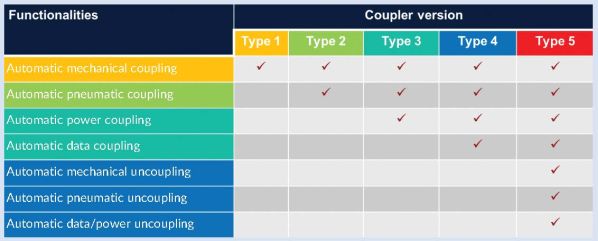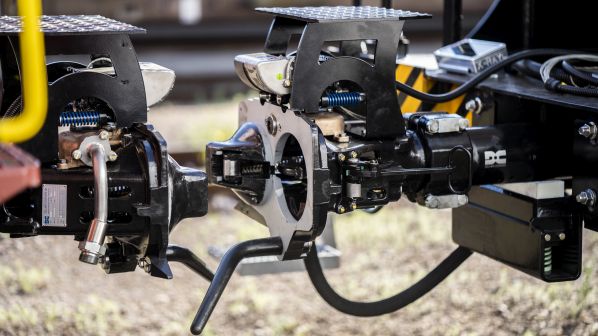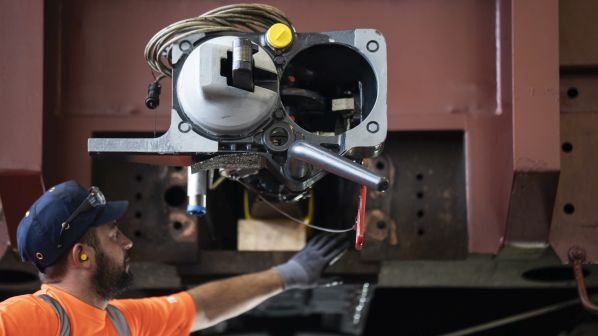ONE regular criticism of the rail industry is that it is too slow to introduce new technologies, especially compared with other industries such as air or road. This is particularly evident with the formation of freight trains, where processes have changed little over recent decades.
Despite major drives to digitise many aspects of rail operation, coupling trains in Europe is still a largely manual task that necessitates depot staff walking the length of the train to manually connect and check each wagon. Staff must also climb between wagons to couple and uncouple them using screw couplings, a physically exhausting operation in a hazardous environment.
Staff from DB Cargo, the largest rail freight operator in Europe, walk around 700,000km a year during train formation, undertaking the manual coupling process 54,000 times a day.
In order to remove this highly inefficient process, which has remained largely unchanged over the past 50 years, a number of projects across Europe obtained traction around the middle of last year to develop a standard for Digital Automatic Couplings (DAC) in order to permit introduction across the European Union (EU).
A DAC supports the automatic connection of physical components such as the mechanical connectors and air pipes. It can also connect digital elements such as power and data. The technology is the most important precondition for automated train preparation and digital rail freight operation.
The development of DAC, initiated under Shift2Rail’s (S2R) Freight Innovation Programme (IP5), was accelerated after a consortium led by German Rail (DB) launched the complementary DAC4EU project, running from July 2020 until December 2022. The consortium includes DB, DB Cargo, SBB Cargo, Rail Cargo Austria and freight wagon leasers Ermewa, GATX Rail Europe and VTG, with the €13m project funded by the German Federal Ministry of Transport and Digital Infrastructure (BMVI).
During the first stage of the project, 12 freight and tank wagons from DB Cargo and GATX have been equipped with coupling prototypes from four different manufacturers: CAF, Dellner, Wabtec and Voith. Technical tests will then be undertaken to identify the DAC coupling type performances.
Those same four digital coupling prototypes are also currently being tested under S2R’s Freight Innovation Programme in winter test conditions in Sweden. Green Cargo will be used for the winter tests with the help of Trafikverket.
The projects already underway through S2R’s IP5 together with the DAC4EU results will feed into the European DAC Delivery Programme (EDDP).
In the second stage of the DAC4EU, a demonstrator train consisting of 24 freight wagons will be equipped with the preferred coupling, before operating in Germany, Switzerland, Austria and other European countries, including daily use in marshalling yards.
The projects already underway through S2R’s IP5 together with the DAC4EU results will feed into the European DAC Delivery Programme (EDDP) through which the sector is expected to select the European solution to be deployed in the years to come. The programme (see panel below) was approved by S2R’s governing board on July 23 2020 and will work to ensure widespread adoption and deployment of DAC across Europe, a major requirement if the new technology is to be effective.
Different types of DAC have been identified to perform different functions (Figure 1). However, in general, automation will increase coupling efficiency as well as provide sufficient energy supply for telematics applications and support secure data communication throughout the train.

DAC will benefit the entire rail freight sector, including operators, infrastructure managers, and manufacturers. By using DAC, train formation will require less shunting while manual processes such as brake tests and train initialisation will be reduced. The process can also enable the introduction of predictive maintenance and the operation of longer and heavier trains, thereby increasing network capacity.
However, these benefits can only be achieved if a single European-wide system is created. This requires broad sector agreement and the alignment of all ongoing and planned European DAC initiatives.
“This is how and why the EDDP was born, based on a proposal from S2R executive director, Mr Carlo Borghini, under the umbrella of S2R,” says Mr Giorgio Travaini, S2R head of research and innovation. “I was tasked on July 17 2020 by the S2R governing board to set it up as an initiative with its own governance, integrating external initiatives as well as the relevant research outputs of the S2R research and innovation (R&I) programme.”
S2R is working with the European Union Agency for Railways (ERA), under the policies developed by the European Commission (EC), relevant railway associations and technical bodies. The development of DAC is connected in many ways to the Sustainable and Smart Mobility Strategy published by the EC in December 2020.
“In Europe, we are targeting a doubling of rail freight traffic by 2050,” says Ms Elisabeth Werner, director of land transport at the EC’s Directorate-General for Mobility and Transport (DG-Move). “Digitalisation and new technologies such as DAC have been identified as boosters for this objective. DAC will in particular help single wagonload traffic as well as support the introduction of longer and heavier trains. However, time is pressing. It’s important that we work quickly on common specifications that can be included in the European Technical Specifications of Interoperability (TSI), to ensure interoperability across Europe.”
The EDDP’s objectives cover technological assessments of the available solutions, testing and demonstrations, definition of migration plans, assessing the interfaces with other programmes, business cases, and communication and dissemination, all of which will facilitate the deployment of DAC in Europe.
“The deployment of this innovation not only puts EU rail freight at the same level as key rail freight coupling automation regions like the United States, Russia, and China, but also outperforms them by introducing key elements to automatic coupling like brake, power and data,” says Mr Manuel Alarcon Espinosa, S2R IP5 programme manager. “This European DAC solution is the enabler of the very much desired and requested digitalisation and automation of rail freight by the logistics world.”
Programme management
A programme management structure consisting of seven Work Packages (WP) has been set-up to ensure the proper and timely delivery of the programme:
WP1 - Technology, Operations and Standardisation: developing a technical definition and standardisation. The package will propose a coordinated approach for the development of an open EU-wide specification as well as assessment criteria for an applicable DAC type in the EU, including mechanical, pneumatic, electric, and data elements. The WP will feed into the TSI 2022.
WP2 - Testing, Demonstrators and Pilot Projects: the coordination and development of the tests and pilot projects for the SA3, Scharfenberg, and Schwab DAC prototypes. During the second stage, the package will focus on pilot testing the selected type to ensure it adheres to specifications.
WP3 - Migration: developing a migration plan for the conversion of the more than 600,000 wagons in the EU wagon fleet currently equipped with legacy couplers, considering a number of key elements including time, new builds versus retrofits, delivery capacity and wagon approvals.
WP4 - Rail System Capacity and Green Deal: delivering a quantitative and qualitative indication of how the technology will increase capacity.
WP5 - Costs, Business Cases and Financing: delivering a financial framework for the deployment of DAC. The package will also create a number of use cases to help create a global cost-benefit analysis to quantify and assess DAC’s competitive advantage in terms of return on investment.
WP6 - Communication and Dissemination: proper dissemination and promotion of the programme conclusions so they are immediately available for use by future S2R initiatives and other important actors in the European railway sector.
WP7 - Further innovation for the “Intelligent Freight Train”: serving as an ‘Integrator and Concentrator’ of all possible innovations that the introduction of the DAC will enable.
Delivery programme
“This initial work has started well, but one of the next important steps in the programme will be to bring even more EU rail actors on board to make the mentioned discussions possible in a wider frame of concerned companies in order to establish a common understanding regarding the respective benefits, costs, migration scenarios and to address funding needs,” says EDDP programme manager, Mr Mark Topal. “In particular, we are targeting actors which are not yet deeply involved. The programme will present a draft target picture for discussion by the different boards as soon as possible. European stakeholders must agree on the main cornerstones of the plan, starting with the priority use cases, but not overlooking factors such as a feasible migration having in mind production and refurbishment capacities as well as operational challenges during this period.
“The first big and real unique opportunity is the programme’s setting in the S2R framework which is advantageous because it brings all stakeholders together including the EC. The timing has also never been more appropriate: DAC will be a major game changer for the modal shift to rail to achieve the ambitious Green Deal objectives.”
The main activities currently underway within the EDDP are the drafting of the specification and testing.

Photo: Deutsche Bahn AG / Patrick Kuschfeld
The proposed DAC prototypes will undergo an in-depth testing programme within the DAC4EU project, including on a test bench, mounted on a wagon, line operation, and operation in extreme climate conditions. The latter will take place in a climatic wind tunnel and on a test train which will run this month in Sweden as part of S2R IP5. The plan is to test operation of the selected coupler in a demonstrator train to identify the potential for further optimisation before the standard is finalised.
The test campaign will help to identify which coupler head design is the best suited concept for a mix of mechanical and electrical coupling. The final decision will be made by the EDDP based on these results along with an evaluation of the life cycle costs for the respective designs.
To combine this work with the necessary standardisation activities, a revision of the standards developed by the CEN has also been launched.
The product-neutral specifications developed from this process will feed into European Committee for Standardisation (CEN) standards and TSIs where needed. With the TSIs under review under the 2022 TSI revision package, ERA has invited experts from the EDDP to take part in the relevant ERA working groups to facilitate the integration of the specification into the relevant TSIs.
“The impacted TSIs will be the TSI Wagon, TSI Locomotive and Passenger, TSI Telematics Applications for Freight services (TAF) and perhaps TSI Control Command and Signalling (CCS),” says ERA project officer, Mr Oscar Martos. “The objective of the working group is to propose amendments to the TSIs containing the DAC aspects to the EC as part as the 2022 TSI revision package. An updated EN Standard will not arrive in time to be referenced in the 2022 TSI revision package but it will certainly be considered in future revisions.”
To combine this work with the necessary standardisation activities, a revision of the standards developed by the CEN has also been launched.
“The EDDP is heavily involved in the definition of a new DAC European standard and is actively collaborating with CEN,” says Mr Johan Ahman, head of engineering at Dellner Couplers. Ahman chairs a sub-working group that creates definitions for the mechanical interfaces and requirements, while the electrical interface standards are developed by the European Committee for Electrotechnical Standardisation (Cenelec).
“A first draft is expected to be ready during 2021, and a final CEN standard in 2023,” Ahman says.
Work on indicative DAC migration scenarios has also begun and any use cases made possible by automation are being prioritised. This will feed into the overall costs and benefits evaluation, and will consider the overall societal and ecological benefits of such a programme.
The challenges facing EDDP are significant, with estimates indicating around 450,000 to 500,000 wagons will need to be retrofitted over six to eight years. EDDP says it is seriously looking at the possibility of a shorter migration period to reduce the impact on rail freight performance caused by a prolonged period of operating with both DAC and legacy couplings.
Another challenge is equipping locomotives to shunt wagons equipped with DAC while also retaining the ability to shunt wagons equipped with legacy couplers.
The development of a hybrid DAC, capable of connecting with both systems, was explored but analysis found that the technically complex system would be costly and too heavy. The new additional functionality would also be made redundant following the full migration to DAC. Instead, a smart and sustainable migration to a single new system appears to be the most viable option to gain a return on investment and create a new business model for rail freight.
The migration plan will also need to take into account interoperability and strategies to deliver the Single European Rail Area (SERA), as well as maintaining cross-border services with non-EU countries such as Switzerland, Russia, Ukraine, Belarus, Serbia, and Turkey.
DAC’s potential to unlock significant capacity as well as improve the quality of rail freight performance is an important step to bringing rail freight into the 21st century. But as with any new development, there is an important ongoing discussion about who pays for implementation. Nevertheless, the business case for DAC remains sound.
“The programme will build up an offer for European policy makers and EU member states to achieve sustainable freight transport in the most affordable way,” Topal says. “The offer will require funding that will, however, amount to less than the cost of building new infrastructure and paying for external costs which would persist, and even increase, if transport of freight does not shift to rail.”
European DAC Delivery Programme structure
THE EDDP project involves 35 entities in Europe, which are providing input across the different work packages.
While enabled by S2R, the EDDP has its own separate decision making structure, with stakeholders representing the rail community. The EDDP supervisory board is chaired by the European Commission, which is providing sectorial alignment and political support at the European level. It is composed of the relevant official representative bodies from the railway sector acting at EU level, as well as Rail Freight Forward (RFF) and the International Union of Railways (UIC) as observers.
The EDDP programme board, chaired by S2R executive director, Mr Carlo Borghini, is responsible for taking decisions for implementation based on the technical input received from the work packages. The board comprises the main rail participants promoting concrete delivery of DAC, including actors outside of S2R’s membership.
“The EDDP is an open programme which looks forward to active participation from stakeholders, who are invited to submit their interest through the dedicated application form on the EDDP website,” Borghini says. “The EDDP is a concrete example of rail research and innovation moving towards industrialisation and future deployment. Together with the sector, we are setting the basis for a new approach to the deployment of innovative technological and operational solutions, driven by the needs of the final users to answer EU policies. This approach will also steer the way to work on the successor to S2R.”

